An Analysis of Marketing Strategies and Models for Tourism (TUI)
VerifiedAdded on 2023/01/13
|13
|4306
|36
Report
AI Summary
This report provides a comprehensive analysis of TUI's marketing strategies within the tourism and hospitality industry. It begins with an introduction to strategic marketing concepts and how destinations are marketed to both domestic and international visitors, emphasizing the importance of highlighting unique selling features and utilizing data analytics. The report then evaluates various marketing models, including STP, marketing mix, and CRM tools, assessing their effectiveness in the tourism sector. A significant portion is dedicated to the components of the marketing mix, detailing TUI's approach to products, pricing, place, promotion, people, physical evidence, and process. It explores how TUI adapts marketing plans, including the Ansoff matrix and Porter's Five Forces, to specific tourism businesses. Furthermore, the report highlights the pivotal role of social media in tourism marketing, emphasizing its impact on customer service, destination promotion, and cost reduction. Finally, the report also identifies sources for identifying strategic marketing models and contemporary market information in tourism and hospitality.
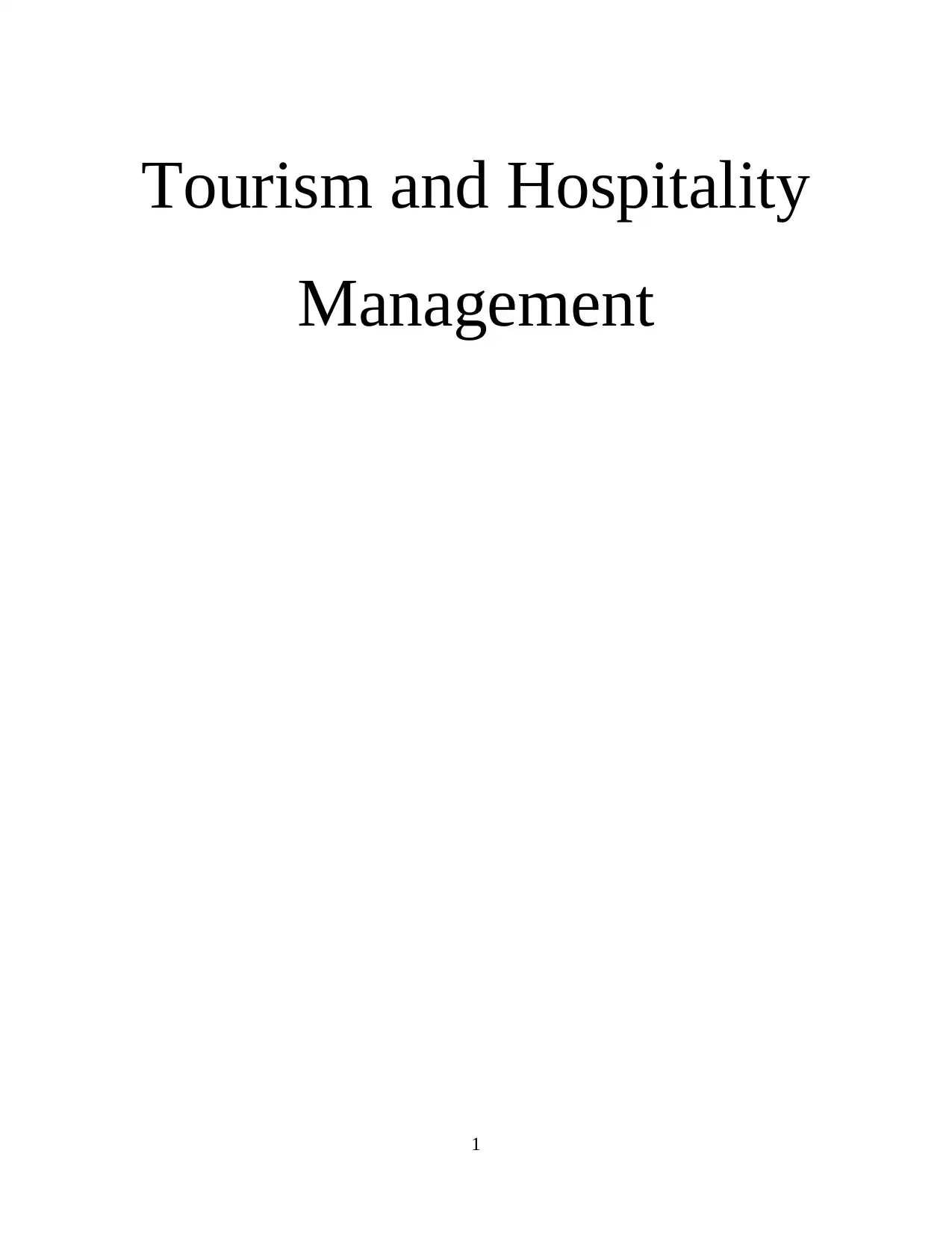
Tourism and Hospitality
Management
1
Management
1
Paraphrase This Document
Need a fresh take? Get an instant paraphrase of this document with our AI Paraphraser
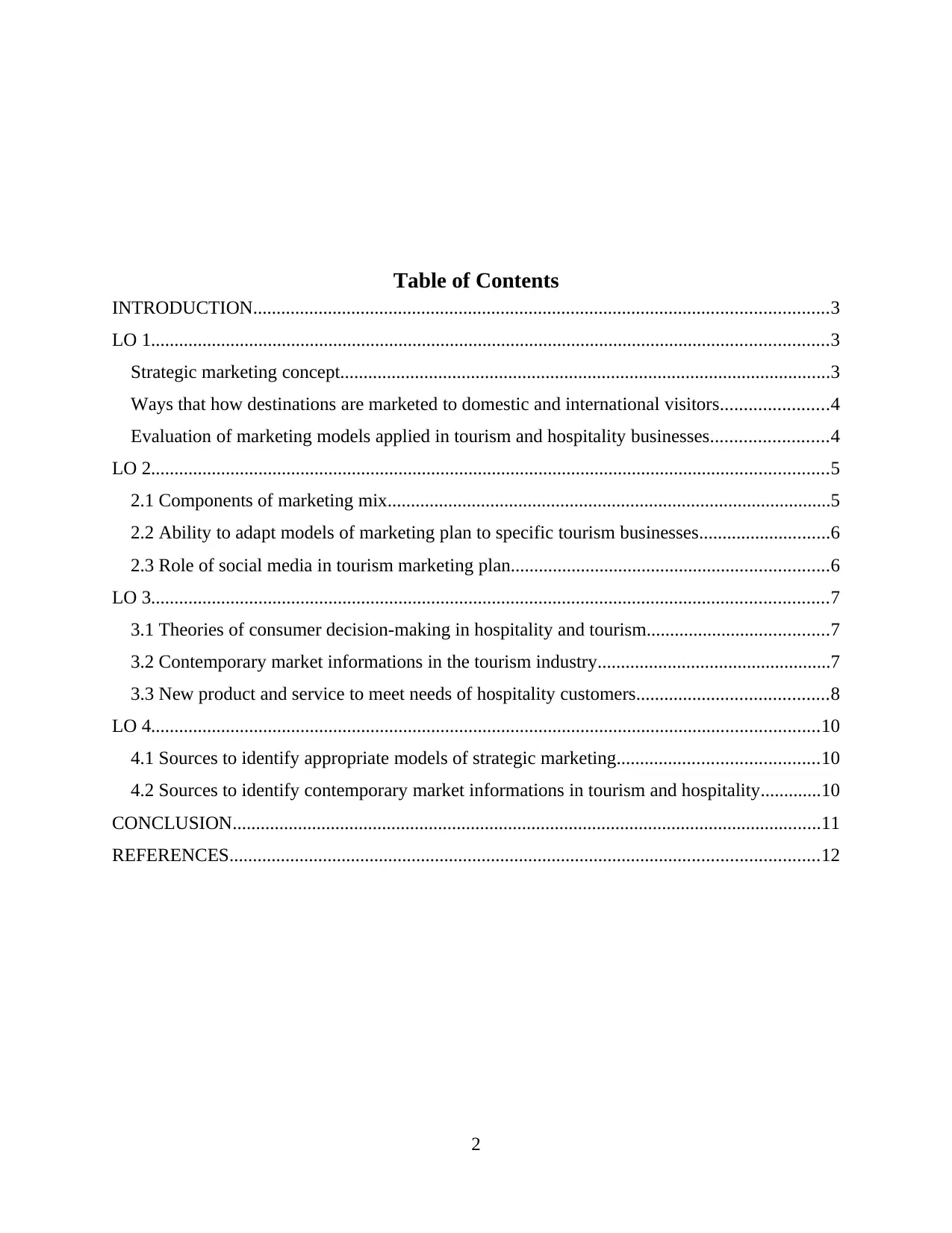
Table of Contents
INTRODUCTION...........................................................................................................................3
LO 1.................................................................................................................................................3
Strategic marketing concept.........................................................................................................3
Ways that how destinations are marketed to domestic and international visitors.......................4
Evaluation of marketing models applied in tourism and hospitality businesses.........................4
LO 2.................................................................................................................................................5
2.1 Components of marketing mix...............................................................................................5
2.2 Ability to adapt models of marketing plan to specific tourism businesses............................6
2.3 Role of social media in tourism marketing plan....................................................................6
LO 3.................................................................................................................................................7
3.1 Theories of consumer decision-making in hospitality and tourism.......................................7
3.2 Contemporary market informations in the tourism industry..................................................7
3.3 New product and service to meet needs of hospitality customers.........................................8
LO 4...............................................................................................................................................10
4.1 Sources to identify appropriate models of strategic marketing...........................................10
4.2 Sources to identify contemporary market informations in tourism and hospitality.............10
CONCLUSION..............................................................................................................................11
REFERENCES..............................................................................................................................12
2
INTRODUCTION...........................................................................................................................3
LO 1.................................................................................................................................................3
Strategic marketing concept.........................................................................................................3
Ways that how destinations are marketed to domestic and international visitors.......................4
Evaluation of marketing models applied in tourism and hospitality businesses.........................4
LO 2.................................................................................................................................................5
2.1 Components of marketing mix...............................................................................................5
2.2 Ability to adapt models of marketing plan to specific tourism businesses............................6
2.3 Role of social media in tourism marketing plan....................................................................6
LO 3.................................................................................................................................................7
3.1 Theories of consumer decision-making in hospitality and tourism.......................................7
3.2 Contemporary market informations in the tourism industry..................................................7
3.3 New product and service to meet needs of hospitality customers.........................................8
LO 4...............................................................................................................................................10
4.1 Sources to identify appropriate models of strategic marketing...........................................10
4.2 Sources to identify contemporary market informations in tourism and hospitality.............10
CONCLUSION..............................................................................................................................11
REFERENCES..............................................................................................................................12
2
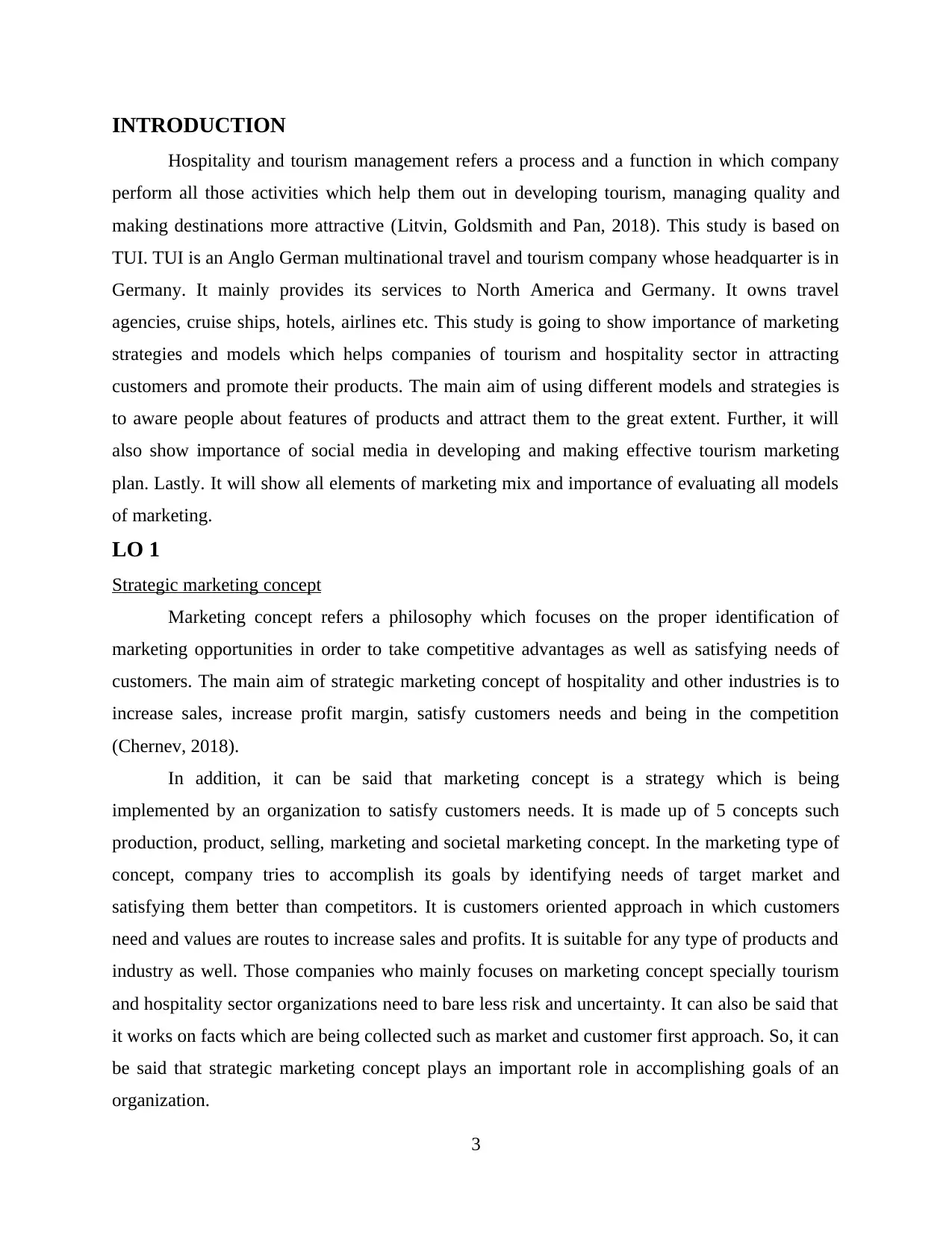
INTRODUCTION
Hospitality and tourism management refers a process and a function in which company
perform all those activities which help them out in developing tourism, managing quality and
making destinations more attractive (Litvin, Goldsmith and Pan, 2018). This study is based on
TUI. TUI is an Anglo German multinational travel and tourism company whose headquarter is in
Germany. It mainly provides its services to North America and Germany. It owns travel
agencies, cruise ships, hotels, airlines etc. This study is going to show importance of marketing
strategies and models which helps companies of tourism and hospitality sector in attracting
customers and promote their products. The main aim of using different models and strategies is
to aware people about features of products and attract them to the great extent. Further, it will
also show importance of social media in developing and making effective tourism marketing
plan. Lastly. It will show all elements of marketing mix and importance of evaluating all models
of marketing.
LO 1
Strategic marketing concept
Marketing concept refers a philosophy which focuses on the proper identification of
marketing opportunities in order to take competitive advantages as well as satisfying needs of
customers. The main aim of strategic marketing concept of hospitality and other industries is to
increase sales, increase profit margin, satisfy customers needs and being in the competition
(Chernev, 2018).
In addition, it can be said that marketing concept is a strategy which is being
implemented by an organization to satisfy customers needs. It is made up of 5 concepts such
production, product, selling, marketing and societal marketing concept. In the marketing type of
concept, company tries to accomplish its goals by identifying needs of target market and
satisfying them better than competitors. It is customers oriented approach in which customers
need and values are routes to increase sales and profits. It is suitable for any type of products and
industry as well. Those companies who mainly focuses on marketing concept specially tourism
and hospitality sector organizations need to bare less risk and uncertainty. It can also be said that
it works on facts which are being collected such as market and customer first approach. So, it can
be said that strategic marketing concept plays an important role in accomplishing goals of an
organization.
3
Hospitality and tourism management refers a process and a function in which company
perform all those activities which help them out in developing tourism, managing quality and
making destinations more attractive (Litvin, Goldsmith and Pan, 2018). This study is based on
TUI. TUI is an Anglo German multinational travel and tourism company whose headquarter is in
Germany. It mainly provides its services to North America and Germany. It owns travel
agencies, cruise ships, hotels, airlines etc. This study is going to show importance of marketing
strategies and models which helps companies of tourism and hospitality sector in attracting
customers and promote their products. The main aim of using different models and strategies is
to aware people about features of products and attract them to the great extent. Further, it will
also show importance of social media in developing and making effective tourism marketing
plan. Lastly. It will show all elements of marketing mix and importance of evaluating all models
of marketing.
LO 1
Strategic marketing concept
Marketing concept refers a philosophy which focuses on the proper identification of
marketing opportunities in order to take competitive advantages as well as satisfying needs of
customers. The main aim of strategic marketing concept of hospitality and other industries is to
increase sales, increase profit margin, satisfy customers needs and being in the competition
(Chernev, 2018).
In addition, it can be said that marketing concept is a strategy which is being
implemented by an organization to satisfy customers needs. It is made up of 5 concepts such
production, product, selling, marketing and societal marketing concept. In the marketing type of
concept, company tries to accomplish its goals by identifying needs of target market and
satisfying them better than competitors. It is customers oriented approach in which customers
need and values are routes to increase sales and profits. It is suitable for any type of products and
industry as well. Those companies who mainly focuses on marketing concept specially tourism
and hospitality sector organizations need to bare less risk and uncertainty. It can also be said that
it works on facts which are being collected such as market and customer first approach. So, it can
be said that strategic marketing concept plays an important role in accomplishing goals of an
organization.
3
⊘ This is a preview!⊘
Do you want full access?
Subscribe today to unlock all pages.

Trusted by 1+ million students worldwide
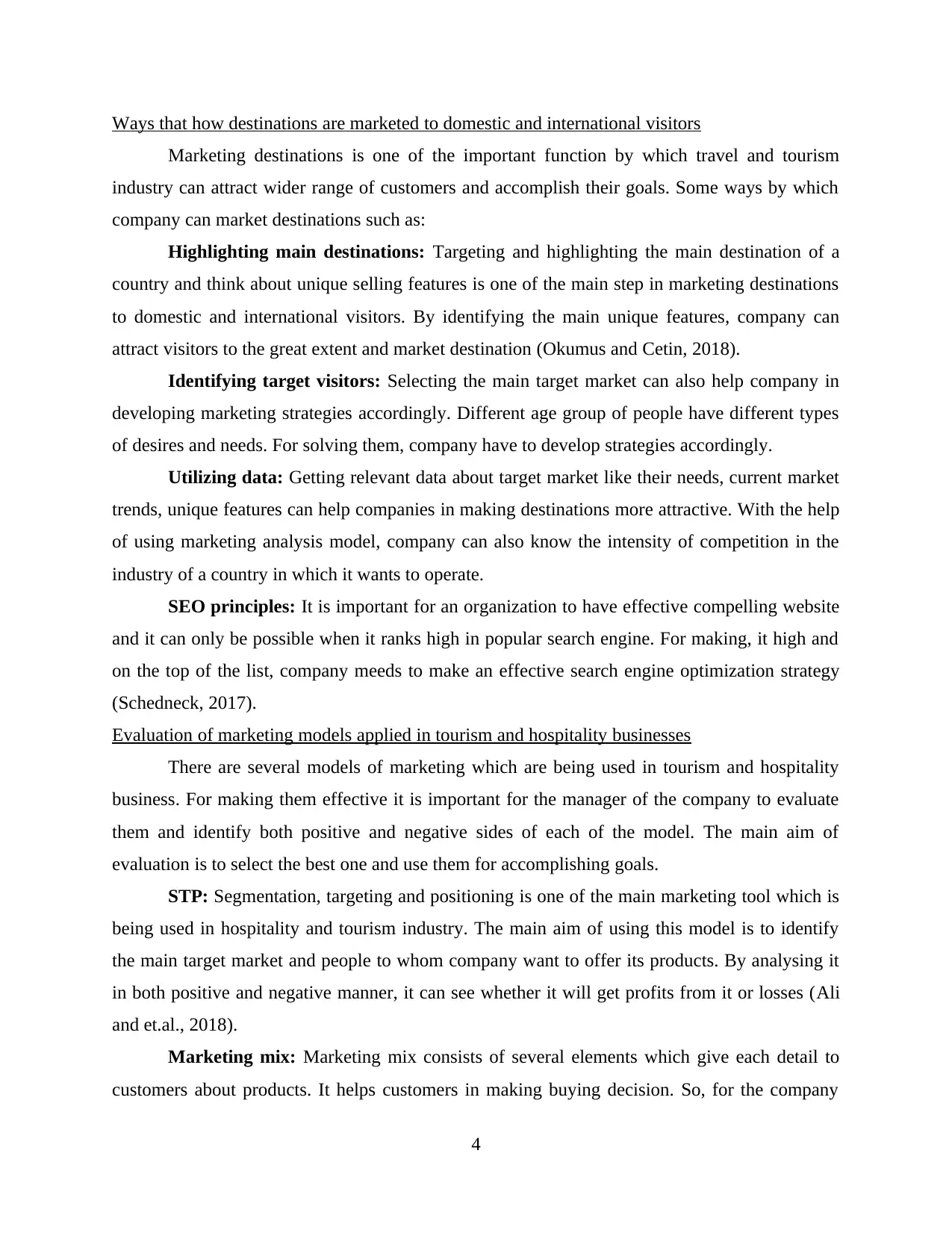
Ways that how destinations are marketed to domestic and international visitors
Marketing destinations is one of the important function by which travel and tourism
industry can attract wider range of customers and accomplish their goals. Some ways by which
company can market destinations such as:
Highlighting main destinations: Targeting and highlighting the main destination of a
country and think about unique selling features is one of the main step in marketing destinations
to domestic and international visitors. By identifying the main unique features, company can
attract visitors to the great extent and market destination (Okumus and Cetin, 2018).
Identifying target visitors: Selecting the main target market can also help company in
developing marketing strategies accordingly. Different age group of people have different types
of desires and needs. For solving them, company have to develop strategies accordingly.
Utilizing data: Getting relevant data about target market like their needs, current market
trends, unique features can help companies in making destinations more attractive. With the help
of using marketing analysis model, company can also know the intensity of competition in the
industry of a country in which it wants to operate.
SEO principles: It is important for an organization to have effective compelling website
and it can only be possible when it ranks high in popular search engine. For making, it high and
on the top of the list, company meeds to make an effective search engine optimization strategy
(Schedneck, 2017).
Evaluation of marketing models applied in tourism and hospitality businesses
There are several models of marketing which are being used in tourism and hospitality
business. For making them effective it is important for the manager of the company to evaluate
them and identify both positive and negative sides of each of the model. The main aim of
evaluation is to select the best one and use them for accomplishing goals.
STP: Segmentation, targeting and positioning is one of the main marketing tool which is
being used in hospitality and tourism industry. The main aim of using this model is to identify
the main target market and people to whom company want to offer its products. By analysing it
in both positive and negative manner, it can see whether it will get profits from it or losses (Ali
and et.al., 2018).
Marketing mix: Marketing mix consists of several elements which give each detail to
customers about products. It helps customers in making buying decision. So, for the company
4
Marketing destinations is one of the important function by which travel and tourism
industry can attract wider range of customers and accomplish their goals. Some ways by which
company can market destinations such as:
Highlighting main destinations: Targeting and highlighting the main destination of a
country and think about unique selling features is one of the main step in marketing destinations
to domestic and international visitors. By identifying the main unique features, company can
attract visitors to the great extent and market destination (Okumus and Cetin, 2018).
Identifying target visitors: Selecting the main target market can also help company in
developing marketing strategies accordingly. Different age group of people have different types
of desires and needs. For solving them, company have to develop strategies accordingly.
Utilizing data: Getting relevant data about target market like their needs, current market
trends, unique features can help companies in making destinations more attractive. With the help
of using marketing analysis model, company can also know the intensity of competition in the
industry of a country in which it wants to operate.
SEO principles: It is important for an organization to have effective compelling website
and it can only be possible when it ranks high in popular search engine. For making, it high and
on the top of the list, company meeds to make an effective search engine optimization strategy
(Schedneck, 2017).
Evaluation of marketing models applied in tourism and hospitality businesses
There are several models of marketing which are being used in tourism and hospitality
business. For making them effective it is important for the manager of the company to evaluate
them and identify both positive and negative sides of each of the model. The main aim of
evaluation is to select the best one and use them for accomplishing goals.
STP: Segmentation, targeting and positioning is one of the main marketing tool which is
being used in hospitality and tourism industry. The main aim of using this model is to identify
the main target market and people to whom company want to offer its products. By analysing it
in both positive and negative manner, it can see whether it will get profits from it or losses (Ali
and et.al., 2018).
Marketing mix: Marketing mix consists of several elements which give each detail to
customers about products. It helps customers in making buying decision. So, for the company
4
Paraphrase This Document
Need a fresh take? Get an instant paraphrase of this document with our AI Paraphraser
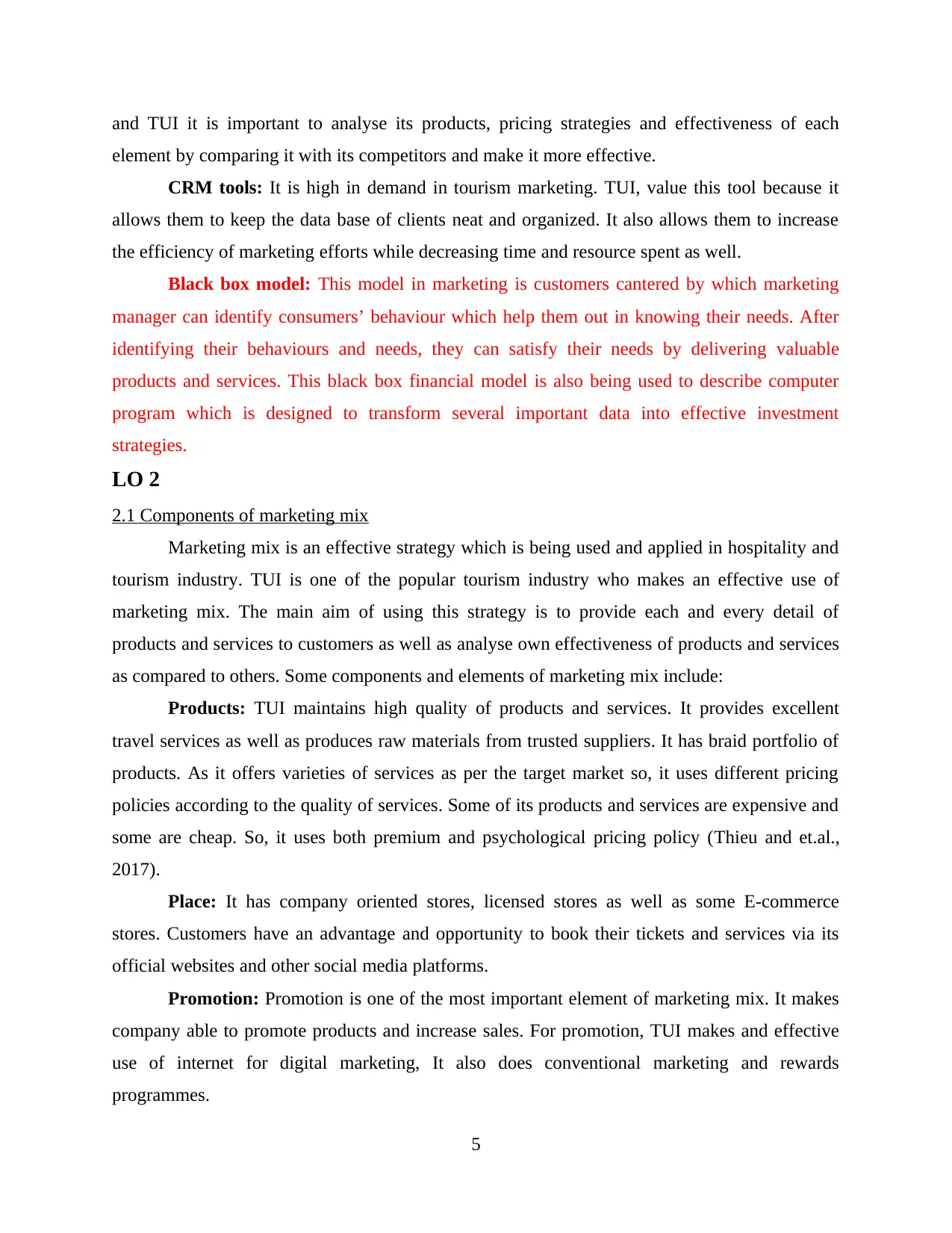
and TUI it is important to analyse its products, pricing strategies and effectiveness of each
element by comparing it with its competitors and make it more effective.
CRM tools: It is high in demand in tourism marketing. TUI, value this tool because it
allows them to keep the data base of clients neat and organized. It also allows them to increase
the efficiency of marketing efforts while decreasing time and resource spent as well.
Black box model: This model in marketing is customers cantered by which marketing
manager can identify consumers’ behaviour which help them out in knowing their needs. After
identifying their behaviours and needs, they can satisfy their needs by delivering valuable
products and services. This black box financial model is also being used to describe computer
program which is designed to transform several important data into effective investment
strategies.
LO 2
2.1 Components of marketing mix
Marketing mix is an effective strategy which is being used and applied in hospitality and
tourism industry. TUI is one of the popular tourism industry who makes an effective use of
marketing mix. The main aim of using this strategy is to provide each and every detail of
products and services to customers as well as analyse own effectiveness of products and services
as compared to others. Some components and elements of marketing mix include:
Products: TUI maintains high quality of products and services. It provides excellent
travel services as well as produces raw materials from trusted suppliers. It has braid portfolio of
products. As it offers varieties of services as per the target market so, it uses different pricing
policies according to the quality of services. Some of its products and services are expensive and
some are cheap. So, it uses both premium and psychological pricing policy (Thieu and et.al.,
2017).
Place: It has company oriented stores, licensed stores as well as some E-commerce
stores. Customers have an advantage and opportunity to book their tickets and services via its
official websites and other social media platforms.
Promotion: Promotion is one of the most important element of marketing mix. It makes
company able to promote products and increase sales. For promotion, TUI makes and effective
use of internet for digital marketing, It also does conventional marketing and rewards
programmes.
5
element by comparing it with its competitors and make it more effective.
CRM tools: It is high in demand in tourism marketing. TUI, value this tool because it
allows them to keep the data base of clients neat and organized. It also allows them to increase
the efficiency of marketing efforts while decreasing time and resource spent as well.
Black box model: This model in marketing is customers cantered by which marketing
manager can identify consumers’ behaviour which help them out in knowing their needs. After
identifying their behaviours and needs, they can satisfy their needs by delivering valuable
products and services. This black box financial model is also being used to describe computer
program which is designed to transform several important data into effective investment
strategies.
LO 2
2.1 Components of marketing mix
Marketing mix is an effective strategy which is being used and applied in hospitality and
tourism industry. TUI is one of the popular tourism industry who makes an effective use of
marketing mix. The main aim of using this strategy is to provide each and every detail of
products and services to customers as well as analyse own effectiveness of products and services
as compared to others. Some components and elements of marketing mix include:
Products: TUI maintains high quality of products and services. It provides excellent
travel services as well as produces raw materials from trusted suppliers. It has braid portfolio of
products. As it offers varieties of services as per the target market so, it uses different pricing
policies according to the quality of services. Some of its products and services are expensive and
some are cheap. So, it uses both premium and psychological pricing policy (Thieu and et.al.,
2017).
Place: It has company oriented stores, licensed stores as well as some E-commerce
stores. Customers have an advantage and opportunity to book their tickets and services via its
official websites and other social media platforms.
Promotion: Promotion is one of the most important element of marketing mix. It makes
company able to promote products and increase sales. For promotion, TUI makes and effective
use of internet for digital marketing, It also does conventional marketing and rewards
programmes.
5
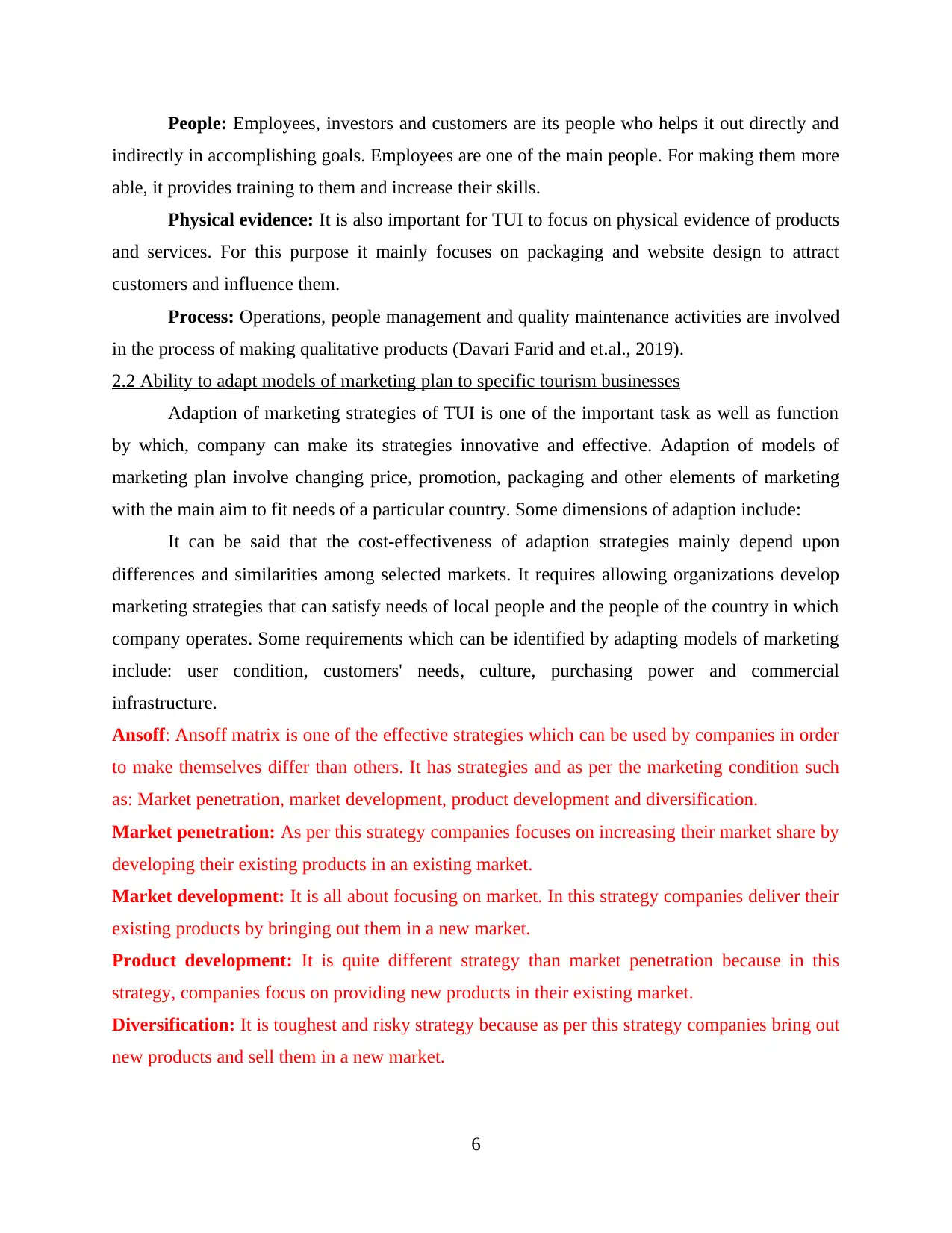
People: Employees, investors and customers are its people who helps it out directly and
indirectly in accomplishing goals. Employees are one of the main people. For making them more
able, it provides training to them and increase their skills.
Physical evidence: It is also important for TUI to focus on physical evidence of products
and services. For this purpose it mainly focuses on packaging and website design to attract
customers and influence them.
Process: Operations, people management and quality maintenance activities are involved
in the process of making qualitative products (Davari Farid and et.al., 2019).
2.2 Ability to adapt models of marketing plan to specific tourism businesses
Adaption of marketing strategies of TUI is one of the important task as well as function
by which, company can make its strategies innovative and effective. Adaption of models of
marketing plan involve changing price, promotion, packaging and other elements of marketing
with the main aim to fit needs of a particular country. Some dimensions of adaption include:
It can be said that the cost-effectiveness of adaption strategies mainly depend upon
differences and similarities among selected markets. It requires allowing organizations develop
marketing strategies that can satisfy needs of local people and the people of the country in which
company operates. Some requirements which can be identified by adapting models of marketing
include: user condition, customers' needs, culture, purchasing power and commercial
infrastructure.
Ansoff: Ansoff matrix is one of the effective strategies which can be used by companies in order
to make themselves differ than others. It has strategies and as per the marketing condition such
as: Market penetration, market development, product development and diversification.
Market penetration: As per this strategy companies focuses on increasing their market share by
developing their existing products in an existing market.
Market development: It is all about focusing on market. In this strategy companies deliver their
existing products by bringing out them in a new market.
Product development: It is quite different strategy than market penetration because in this
strategy, companies focus on providing new products in their existing market.
Diversification: It is toughest and risky strategy because as per this strategy companies bring out
new products and sell them in a new market.
6
indirectly in accomplishing goals. Employees are one of the main people. For making them more
able, it provides training to them and increase their skills.
Physical evidence: It is also important for TUI to focus on physical evidence of products
and services. For this purpose it mainly focuses on packaging and website design to attract
customers and influence them.
Process: Operations, people management and quality maintenance activities are involved
in the process of making qualitative products (Davari Farid and et.al., 2019).
2.2 Ability to adapt models of marketing plan to specific tourism businesses
Adaption of marketing strategies of TUI is one of the important task as well as function
by which, company can make its strategies innovative and effective. Adaption of models of
marketing plan involve changing price, promotion, packaging and other elements of marketing
with the main aim to fit needs of a particular country. Some dimensions of adaption include:
It can be said that the cost-effectiveness of adaption strategies mainly depend upon
differences and similarities among selected markets. It requires allowing organizations develop
marketing strategies that can satisfy needs of local people and the people of the country in which
company operates. Some requirements which can be identified by adapting models of marketing
include: user condition, customers' needs, culture, purchasing power and commercial
infrastructure.
Ansoff: Ansoff matrix is one of the effective strategies which can be used by companies in order
to make themselves differ than others. It has strategies and as per the marketing condition such
as: Market penetration, market development, product development and diversification.
Market penetration: As per this strategy companies focuses on increasing their market share by
developing their existing products in an existing market.
Market development: It is all about focusing on market. In this strategy companies deliver their
existing products by bringing out them in a new market.
Product development: It is quite different strategy than market penetration because in this
strategy, companies focus on providing new products in their existing market.
Diversification: It is toughest and risky strategy because as per this strategy companies bring out
new products and sell them in a new market.
6
⊘ This is a preview!⊘
Do you want full access?
Subscribe today to unlock all pages.

Trusted by 1+ million students worldwide
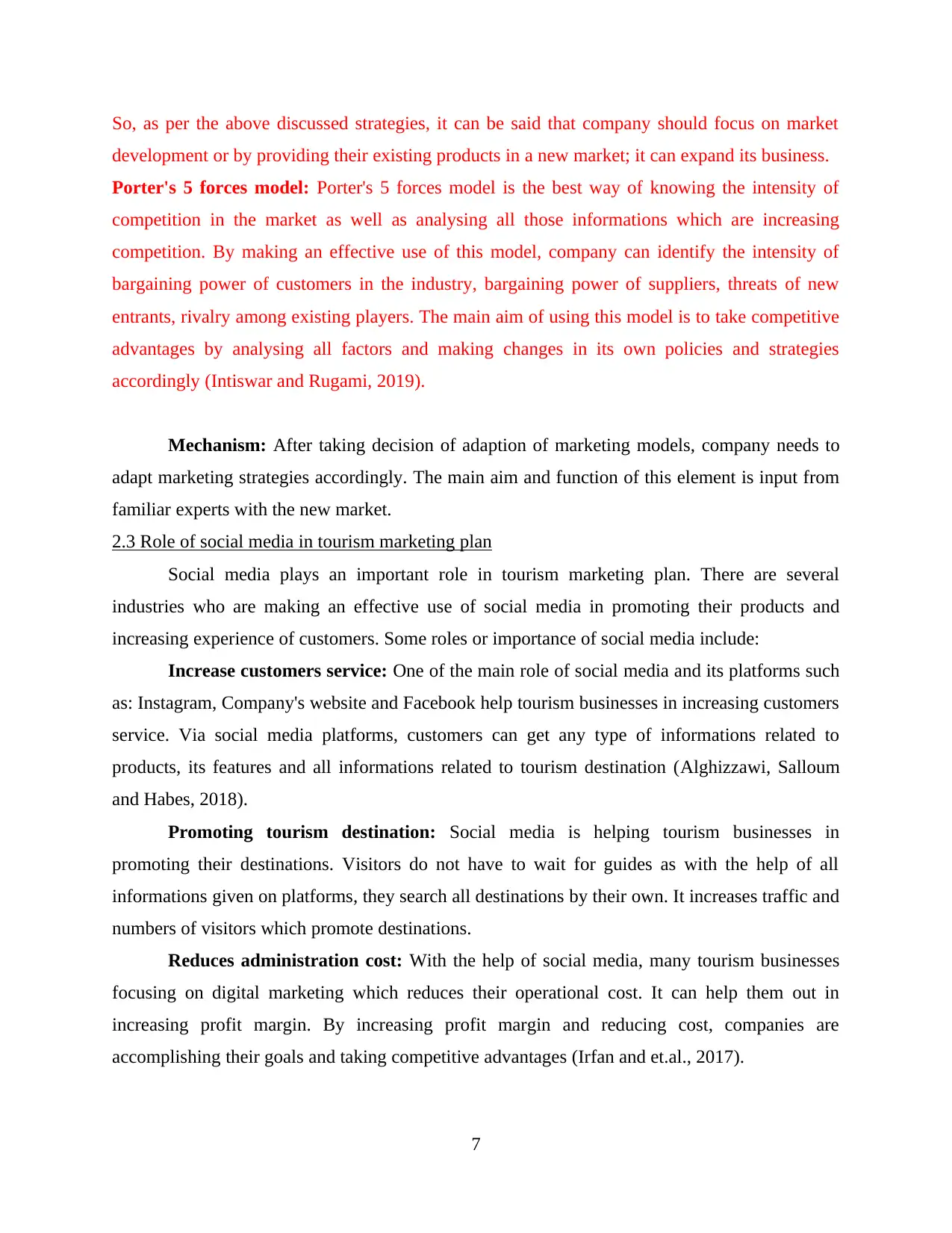
So, as per the above discussed strategies, it can be said that company should focus on market
development or by providing their existing products in a new market; it can expand its business.
Porter's 5 forces model: Porter's 5 forces model is the best way of knowing the intensity of
competition in the market as well as analysing all those informations which are increasing
competition. By making an effective use of this model, company can identify the intensity of
bargaining power of customers in the industry, bargaining power of suppliers, threats of new
entrants, rivalry among existing players. The main aim of using this model is to take competitive
advantages by analysing all factors and making changes in its own policies and strategies
accordingly (Intiswar and Rugami, 2019).
Mechanism: After taking decision of adaption of marketing models, company needs to
adapt marketing strategies accordingly. The main aim and function of this element is input from
familiar experts with the new market.
2.3 Role of social media in tourism marketing plan
Social media plays an important role in tourism marketing plan. There are several
industries who are making an effective use of social media in promoting their products and
increasing experience of customers. Some roles or importance of social media include:
Increase customers service: One of the main role of social media and its platforms such
as: Instagram, Company's website and Facebook help tourism businesses in increasing customers
service. Via social media platforms, customers can get any type of informations related to
products, its features and all informations related to tourism destination (Alghizzawi, Salloum
and Habes, 2018).
Promoting tourism destination: Social media is helping tourism businesses in
promoting their destinations. Visitors do not have to wait for guides as with the help of all
informations given on platforms, they search all destinations by their own. It increases traffic and
numbers of visitors which promote destinations.
Reduces administration cost: With the help of social media, many tourism businesses
focusing on digital marketing which reduces their operational cost. It can help them out in
increasing profit margin. By increasing profit margin and reducing cost, companies are
accomplishing their goals and taking competitive advantages (Irfan and et.al., 2017).
7
development or by providing their existing products in a new market; it can expand its business.
Porter's 5 forces model: Porter's 5 forces model is the best way of knowing the intensity of
competition in the market as well as analysing all those informations which are increasing
competition. By making an effective use of this model, company can identify the intensity of
bargaining power of customers in the industry, bargaining power of suppliers, threats of new
entrants, rivalry among existing players. The main aim of using this model is to take competitive
advantages by analysing all factors and making changes in its own policies and strategies
accordingly (Intiswar and Rugami, 2019).
Mechanism: After taking decision of adaption of marketing models, company needs to
adapt marketing strategies accordingly. The main aim and function of this element is input from
familiar experts with the new market.
2.3 Role of social media in tourism marketing plan
Social media plays an important role in tourism marketing plan. There are several
industries who are making an effective use of social media in promoting their products and
increasing experience of customers. Some roles or importance of social media include:
Increase customers service: One of the main role of social media and its platforms such
as: Instagram, Company's website and Facebook help tourism businesses in increasing customers
service. Via social media platforms, customers can get any type of informations related to
products, its features and all informations related to tourism destination (Alghizzawi, Salloum
and Habes, 2018).
Promoting tourism destination: Social media is helping tourism businesses in
promoting their destinations. Visitors do not have to wait for guides as with the help of all
informations given on platforms, they search all destinations by their own. It increases traffic and
numbers of visitors which promote destinations.
Reduces administration cost: With the help of social media, many tourism businesses
focusing on digital marketing which reduces their operational cost. It can help them out in
increasing profit margin. By increasing profit margin and reducing cost, companies are
accomplishing their goals and taking competitive advantages (Irfan and et.al., 2017).
7
Paraphrase This Document
Need a fresh take? Get an instant paraphrase of this document with our AI Paraphraser
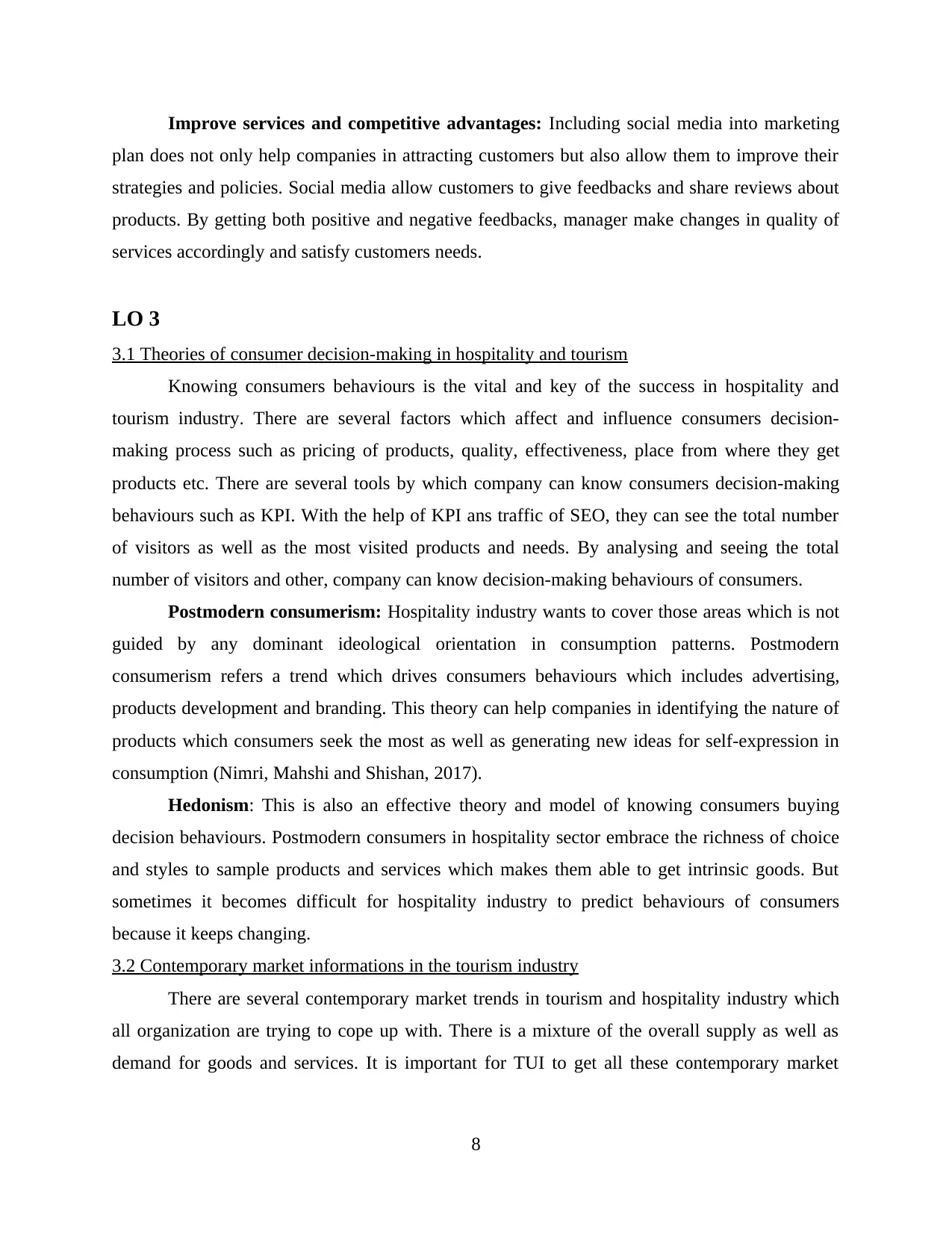
Improve services and competitive advantages: Including social media into marketing
plan does not only help companies in attracting customers but also allow them to improve their
strategies and policies. Social media allow customers to give feedbacks and share reviews about
products. By getting both positive and negative feedbacks, manager make changes in quality of
services accordingly and satisfy customers needs.
LO 3
3.1 Theories of consumer decision-making in hospitality and tourism
Knowing consumers behaviours is the vital and key of the success in hospitality and
tourism industry. There are several factors which affect and influence consumers decision-
making process such as pricing of products, quality, effectiveness, place from where they get
products etc. There are several tools by which company can know consumers decision-making
behaviours such as KPI. With the help of KPI ans traffic of SEO, they can see the total number
of visitors as well as the most visited products and needs. By analysing and seeing the total
number of visitors and other, company can know decision-making behaviours of consumers.
Postmodern consumerism: Hospitality industry wants to cover those areas which is not
guided by any dominant ideological orientation in consumption patterns. Postmodern
consumerism refers a trend which drives consumers behaviours which includes advertising,
products development and branding. This theory can help companies in identifying the nature of
products which consumers seek the most as well as generating new ideas for self-expression in
consumption (Nimri, Mahshi and Shishan, 2017).
Hedonism: This is also an effective theory and model of knowing consumers buying
decision behaviours. Postmodern consumers in hospitality sector embrace the richness of choice
and styles to sample products and services which makes them able to get intrinsic goods. But
sometimes it becomes difficult for hospitality industry to predict behaviours of consumers
because it keeps changing.
3.2 Contemporary market informations in the tourism industry
There are several contemporary market trends in tourism and hospitality industry which
all organization are trying to cope up with. There is a mixture of the overall supply as well as
demand for goods and services. It is important for TUI to get all these contemporary market
8
plan does not only help companies in attracting customers but also allow them to improve their
strategies and policies. Social media allow customers to give feedbacks and share reviews about
products. By getting both positive and negative feedbacks, manager make changes in quality of
services accordingly and satisfy customers needs.
LO 3
3.1 Theories of consumer decision-making in hospitality and tourism
Knowing consumers behaviours is the vital and key of the success in hospitality and
tourism industry. There are several factors which affect and influence consumers decision-
making process such as pricing of products, quality, effectiveness, place from where they get
products etc. There are several tools by which company can know consumers decision-making
behaviours such as KPI. With the help of KPI ans traffic of SEO, they can see the total number
of visitors as well as the most visited products and needs. By analysing and seeing the total
number of visitors and other, company can know decision-making behaviours of consumers.
Postmodern consumerism: Hospitality industry wants to cover those areas which is not
guided by any dominant ideological orientation in consumption patterns. Postmodern
consumerism refers a trend which drives consumers behaviours which includes advertising,
products development and branding. This theory can help companies in identifying the nature of
products which consumers seek the most as well as generating new ideas for self-expression in
consumption (Nimri, Mahshi and Shishan, 2017).
Hedonism: This is also an effective theory and model of knowing consumers buying
decision behaviours. Postmodern consumers in hospitality sector embrace the richness of choice
and styles to sample products and services which makes them able to get intrinsic goods. But
sometimes it becomes difficult for hospitality industry to predict behaviours of consumers
because it keeps changing.
3.2 Contemporary market informations in the tourism industry
There are several contemporary market trends in tourism and hospitality industry which
all organization are trying to cope up with. There is a mixture of the overall supply as well as
demand for goods and services. It is important for TUI to get all these contemporary market
8
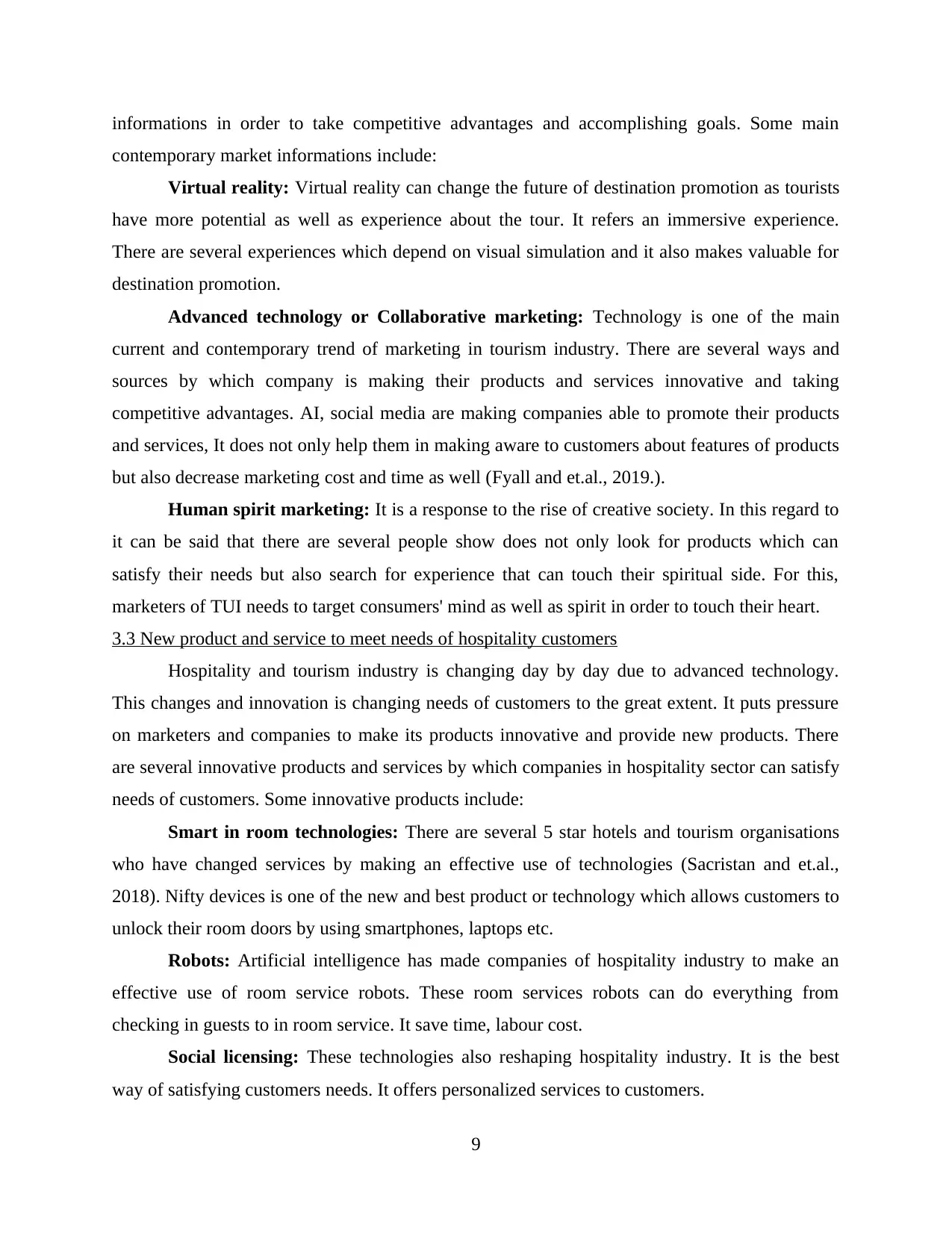
informations in order to take competitive advantages and accomplishing goals. Some main
contemporary market informations include:
Virtual reality: Virtual reality can change the future of destination promotion as tourists
have more potential as well as experience about the tour. It refers an immersive experience.
There are several experiences which depend on visual simulation and it also makes valuable for
destination promotion.
Advanced technology or Collaborative marketing: Technology is one of the main
current and contemporary trend of marketing in tourism industry. There are several ways and
sources by which company is making their products and services innovative and taking
competitive advantages. AI, social media are making companies able to promote their products
and services, It does not only help them in making aware to customers about features of products
but also decrease marketing cost and time as well (Fyall and et.al., 2019.).
Human spirit marketing: It is a response to the rise of creative society. In this regard to
it can be said that there are several people show does not only look for products which can
satisfy their needs but also search for experience that can touch their spiritual side. For this,
marketers of TUI needs to target consumers' mind as well as spirit in order to touch their heart.
3.3 New product and service to meet needs of hospitality customers
Hospitality and tourism industry is changing day by day due to advanced technology.
This changes and innovation is changing needs of customers to the great extent. It puts pressure
on marketers and companies to make its products innovative and provide new products. There
are several innovative products and services by which companies in hospitality sector can satisfy
needs of customers. Some innovative products include:
Smart in room technologies: There are several 5 star hotels and tourism organisations
who have changed services by making an effective use of technologies (Sacristan and et.al.,
2018). Nifty devices is one of the new and best product or technology which allows customers to
unlock their room doors by using smartphones, laptops etc.
Robots: Artificial intelligence has made companies of hospitality industry to make an
effective use of room service robots. These room services robots can do everything from
checking in guests to in room service. It save time, labour cost.
Social licensing: These technologies also reshaping hospitality industry. It is the best
way of satisfying customers needs. It offers personalized services to customers.
9
contemporary market informations include:
Virtual reality: Virtual reality can change the future of destination promotion as tourists
have more potential as well as experience about the tour. It refers an immersive experience.
There are several experiences which depend on visual simulation and it also makes valuable for
destination promotion.
Advanced technology or Collaborative marketing: Technology is one of the main
current and contemporary trend of marketing in tourism industry. There are several ways and
sources by which company is making their products and services innovative and taking
competitive advantages. AI, social media are making companies able to promote their products
and services, It does not only help them in making aware to customers about features of products
but also decrease marketing cost and time as well (Fyall and et.al., 2019.).
Human spirit marketing: It is a response to the rise of creative society. In this regard to
it can be said that there are several people show does not only look for products which can
satisfy their needs but also search for experience that can touch their spiritual side. For this,
marketers of TUI needs to target consumers' mind as well as spirit in order to touch their heart.
3.3 New product and service to meet needs of hospitality customers
Hospitality and tourism industry is changing day by day due to advanced technology.
This changes and innovation is changing needs of customers to the great extent. It puts pressure
on marketers and companies to make its products innovative and provide new products. There
are several innovative products and services by which companies in hospitality sector can satisfy
needs of customers. Some innovative products include:
Smart in room technologies: There are several 5 star hotels and tourism organisations
who have changed services by making an effective use of technologies (Sacristan and et.al.,
2018). Nifty devices is one of the new and best product or technology which allows customers to
unlock their room doors by using smartphones, laptops etc.
Robots: Artificial intelligence has made companies of hospitality industry to make an
effective use of room service robots. These room services robots can do everything from
checking in guests to in room service. It save time, labour cost.
Social licensing: These technologies also reshaping hospitality industry. It is the best
way of satisfying customers needs. It offers personalized services to customers.
9
⊘ This is a preview!⊘
Do you want full access?
Subscribe today to unlock all pages.

Trusted by 1+ million students worldwide
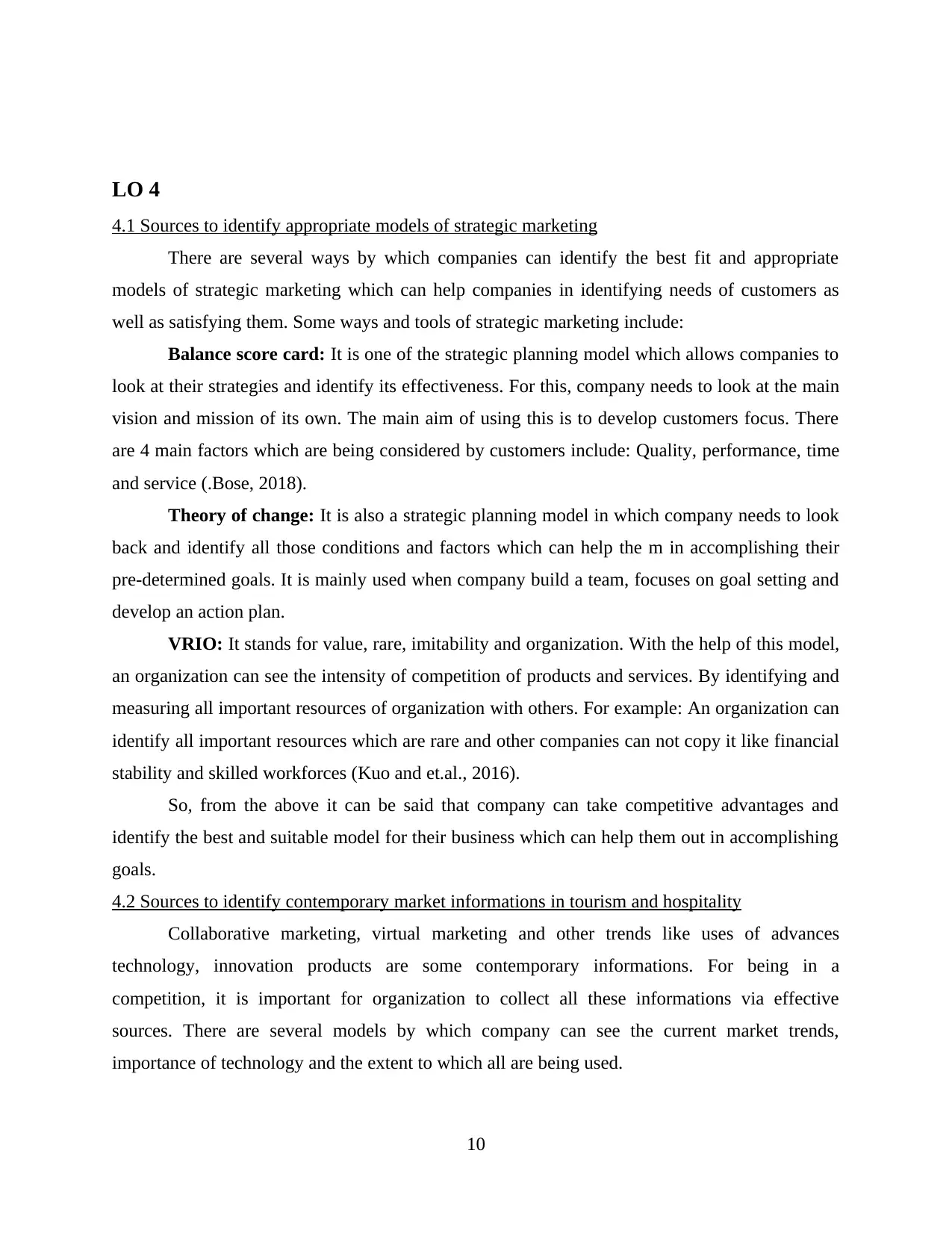
LO 4
4.1 Sources to identify appropriate models of strategic marketing
There are several ways by which companies can identify the best fit and appropriate
models of strategic marketing which can help companies in identifying needs of customers as
well as satisfying them. Some ways and tools of strategic marketing include:
Balance score card: It is one of the strategic planning model which allows companies to
look at their strategies and identify its effectiveness. For this, company needs to look at the main
vision and mission of its own. The main aim of using this is to develop customers focus. There
are 4 main factors which are being considered by customers include: Quality, performance, time
and service (.Bose, 2018).
Theory of change: It is also a strategic planning model in which company needs to look
back and identify all those conditions and factors which can help the m in accomplishing their
pre-determined goals. It is mainly used when company build a team, focuses on goal setting and
develop an action plan.
VRIO: It stands for value, rare, imitability and organization. With the help of this model,
an organization can see the intensity of competition of products and services. By identifying and
measuring all important resources of organization with others. For example: An organization can
identify all important resources which are rare and other companies can not copy it like financial
stability and skilled workforces (Kuo and et.al., 2016).
So, from the above it can be said that company can take competitive advantages and
identify the best and suitable model for their business which can help them out in accomplishing
goals.
4.2 Sources to identify contemporary market informations in tourism and hospitality
Collaborative marketing, virtual marketing and other trends like uses of advances
technology, innovation products are some contemporary informations. For being in a
competition, it is important for organization to collect all these informations via effective
sources. There are several models by which company can see the current market trends,
importance of technology and the extent to which all are being used.
10
4.1 Sources to identify appropriate models of strategic marketing
There are several ways by which companies can identify the best fit and appropriate
models of strategic marketing which can help companies in identifying needs of customers as
well as satisfying them. Some ways and tools of strategic marketing include:
Balance score card: It is one of the strategic planning model which allows companies to
look at their strategies and identify its effectiveness. For this, company needs to look at the main
vision and mission of its own. The main aim of using this is to develop customers focus. There
are 4 main factors which are being considered by customers include: Quality, performance, time
and service (.Bose, 2018).
Theory of change: It is also a strategic planning model in which company needs to look
back and identify all those conditions and factors which can help the m in accomplishing their
pre-determined goals. It is mainly used when company build a team, focuses on goal setting and
develop an action plan.
VRIO: It stands for value, rare, imitability and organization. With the help of this model,
an organization can see the intensity of competition of products and services. By identifying and
measuring all important resources of organization with others. For example: An organization can
identify all important resources which are rare and other companies can not copy it like financial
stability and skilled workforces (Kuo and et.al., 2016).
So, from the above it can be said that company can take competitive advantages and
identify the best and suitable model for their business which can help them out in accomplishing
goals.
4.2 Sources to identify contemporary market informations in tourism and hospitality
Collaborative marketing, virtual marketing and other trends like uses of advances
technology, innovation products are some contemporary informations. For being in a
competition, it is important for organization to collect all these informations via effective
sources. There are several models by which company can see the current market trends,
importance of technology and the extent to which all are being used.
10
Paraphrase This Document
Need a fresh take? Get an instant paraphrase of this document with our AI Paraphraser
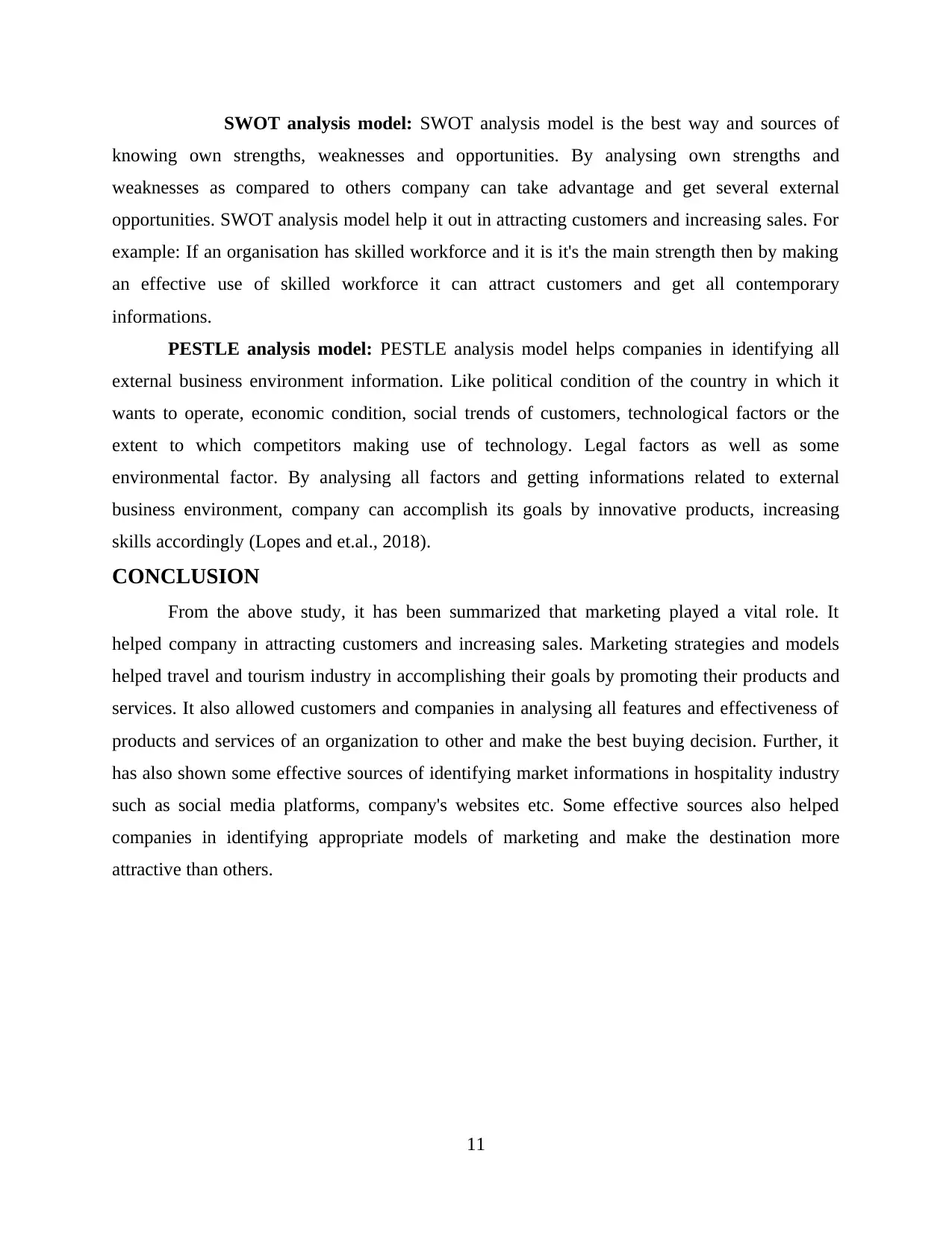
SWOT analysis model: SWOT analysis model is the best way and sources of
knowing own strengths, weaknesses and opportunities. By analysing own strengths and
weaknesses as compared to others company can take advantage and get several external
opportunities. SWOT analysis model help it out in attracting customers and increasing sales. For
example: If an organisation has skilled workforce and it is it's the main strength then by making
an effective use of skilled workforce it can attract customers and get all contemporary
informations.
PESTLE analysis model: PESTLE analysis model helps companies in identifying all
external business environment information. Like political condition of the country in which it
wants to operate, economic condition, social trends of customers, technological factors or the
extent to which competitors making use of technology. Legal factors as well as some
environmental factor. By analysing all factors and getting informations related to external
business environment, company can accomplish its goals by innovative products, increasing
skills accordingly (Lopes and et.al., 2018).
CONCLUSION
From the above study, it has been summarized that marketing played a vital role. It
helped company in attracting customers and increasing sales. Marketing strategies and models
helped travel and tourism industry in accomplishing their goals by promoting their products and
services. It also allowed customers and companies in analysing all features and effectiveness of
products and services of an organization to other and make the best buying decision. Further, it
has also shown some effective sources of identifying market informations in hospitality industry
such as social media platforms, company's websites etc. Some effective sources also helped
companies in identifying appropriate models of marketing and make the destination more
attractive than others.
11
knowing own strengths, weaknesses and opportunities. By analysing own strengths and
weaknesses as compared to others company can take advantage and get several external
opportunities. SWOT analysis model help it out in attracting customers and increasing sales. For
example: If an organisation has skilled workforce and it is it's the main strength then by making
an effective use of skilled workforce it can attract customers and get all contemporary
informations.
PESTLE analysis model: PESTLE analysis model helps companies in identifying all
external business environment information. Like political condition of the country in which it
wants to operate, economic condition, social trends of customers, technological factors or the
extent to which competitors making use of technology. Legal factors as well as some
environmental factor. By analysing all factors and getting informations related to external
business environment, company can accomplish its goals by innovative products, increasing
skills accordingly (Lopes and et.al., 2018).
CONCLUSION
From the above study, it has been summarized that marketing played a vital role. It
helped company in attracting customers and increasing sales. Marketing strategies and models
helped travel and tourism industry in accomplishing their goals by promoting their products and
services. It also allowed customers and companies in analysing all features and effectiveness of
products and services of an organization to other and make the best buying decision. Further, it
has also shown some effective sources of identifying market informations in hospitality industry
such as social media platforms, company's websites etc. Some effective sources also helped
companies in identifying appropriate models of marketing and make the destination more
attractive than others.
11
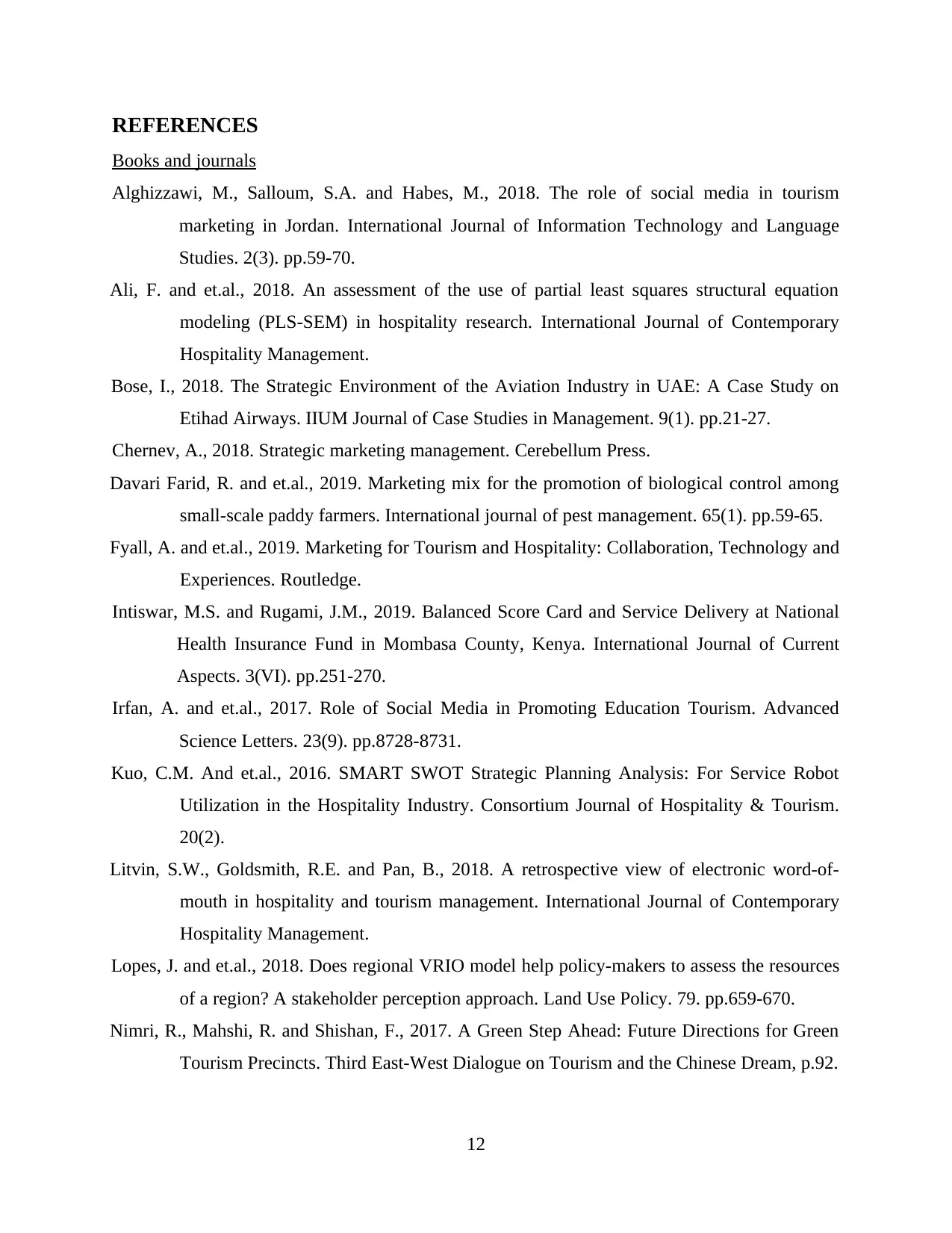
REFERENCES
Books and journals
Alghizzawi, M., Salloum, S.A. and Habes, M., 2018. The role of social media in tourism
marketing in Jordan. International Journal of Information Technology and Language
Studies. 2(3). pp.59-70.
Ali, F. and et.al., 2018. An assessment of the use of partial least squares structural equation
modeling (PLS-SEM) in hospitality research. International Journal of Contemporary
Hospitality Management.
Bose, I., 2018. The Strategic Environment of the Aviation Industry in UAE: A Case Study on
Etihad Airways. IIUM Journal of Case Studies in Management. 9(1). pp.21-27.
Chernev, A., 2018. Strategic marketing management. Cerebellum Press.
Davari Farid, R. and et.al., 2019. Marketing mix for the promotion of biological control among
small-scale paddy farmers. International journal of pest management. 65(1). pp.59-65.
Fyall, A. and et.al., 2019. Marketing for Tourism and Hospitality: Collaboration, Technology and
Experiences. Routledge.
Intiswar, M.S. and Rugami, J.M., 2019. Balanced Score Card and Service Delivery at National
Health Insurance Fund in Mombasa County, Kenya. International Journal of Current
Aspects. 3(VI). pp.251-270.
Irfan, A. and et.al., 2017. Role of Social Media in Promoting Education Tourism. Advanced
Science Letters. 23(9). pp.8728-8731.
Kuo, C.M. And et.al., 2016. SMART SWOT Strategic Planning Analysis: For Service Robot
Utilization in the Hospitality Industry. Consortium Journal of Hospitality & Tourism.
20(2).
Litvin, S.W., Goldsmith, R.E. and Pan, B., 2018. A retrospective view of electronic word-of-
mouth in hospitality and tourism management. International Journal of Contemporary
Hospitality Management.
Lopes, J. and et.al., 2018. Does regional VRIO model help policy-makers to assess the resources
of a region? A stakeholder perception approach. Land Use Policy. 79. pp.659-670.
Nimri, R., Mahshi, R. and Shishan, F., 2017. A Green Step Ahead: Future Directions for Green
Tourism Precincts. Third East-West Dialogue on Tourism and the Chinese Dream, p.92.
12
Books and journals
Alghizzawi, M., Salloum, S.A. and Habes, M., 2018. The role of social media in tourism
marketing in Jordan. International Journal of Information Technology and Language
Studies. 2(3). pp.59-70.
Ali, F. and et.al., 2018. An assessment of the use of partial least squares structural equation
modeling (PLS-SEM) in hospitality research. International Journal of Contemporary
Hospitality Management.
Bose, I., 2018. The Strategic Environment of the Aviation Industry in UAE: A Case Study on
Etihad Airways. IIUM Journal of Case Studies in Management. 9(1). pp.21-27.
Chernev, A., 2018. Strategic marketing management. Cerebellum Press.
Davari Farid, R. and et.al., 2019. Marketing mix for the promotion of biological control among
small-scale paddy farmers. International journal of pest management. 65(1). pp.59-65.
Fyall, A. and et.al., 2019. Marketing for Tourism and Hospitality: Collaboration, Technology and
Experiences. Routledge.
Intiswar, M.S. and Rugami, J.M., 2019. Balanced Score Card and Service Delivery at National
Health Insurance Fund in Mombasa County, Kenya. International Journal of Current
Aspects. 3(VI). pp.251-270.
Irfan, A. and et.al., 2017. Role of Social Media in Promoting Education Tourism. Advanced
Science Letters. 23(9). pp.8728-8731.
Kuo, C.M. And et.al., 2016. SMART SWOT Strategic Planning Analysis: For Service Robot
Utilization in the Hospitality Industry. Consortium Journal of Hospitality & Tourism.
20(2).
Litvin, S.W., Goldsmith, R.E. and Pan, B., 2018. A retrospective view of electronic word-of-
mouth in hospitality and tourism management. International Journal of Contemporary
Hospitality Management.
Lopes, J. and et.al., 2018. Does regional VRIO model help policy-makers to assess the resources
of a region? A stakeholder perception approach. Land Use Policy. 79. pp.659-670.
Nimri, R., Mahshi, R. and Shishan, F., 2017. A Green Step Ahead: Future Directions for Green
Tourism Precincts. Third East-West Dialogue on Tourism and the Chinese Dream, p.92.
12
⊘ This is a preview!⊘
Do you want full access?
Subscribe today to unlock all pages.

Trusted by 1+ million students worldwide
1 out of 13
Related Documents
Your All-in-One AI-Powered Toolkit for Academic Success.
+13062052269
info@desklib.com
Available 24*7 on WhatsApp / Email
![[object Object]](/_next/static/media/star-bottom.7253800d.svg)
Unlock your academic potential
Copyright © 2020–2025 A2Z Services. All Rights Reserved. Developed and managed by ZUCOL.





